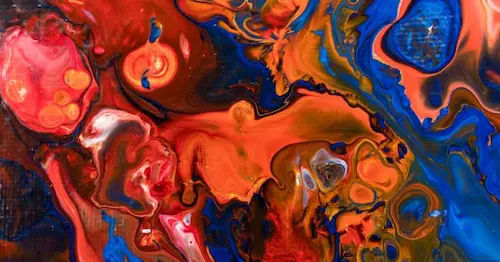Acrylic Pour Singapore

What is global pop culture without art that creates wow effects like acrylic pouring painting?
Of all the contemporary methods of art-making, nothing better reflects the consumerist world in which we live than acrylic pouring paintings.
Almost anyone, through this method of painting, can have multicoloured, flowing neat pictures i.e. abstract art without anyone having to be an artist.
It’s a fun pastime in Singapore where people can ‘pour’ their hearts out and chill while losing themselves in their creations.
In this article, you are advised on where to go for the best acrylic pour painting in Singapore in 2025, from the best acrylic pouring art workshops in Singapore and studios.
What is Acrylic Pouring?

Acrylic pouring is part of the broad category of the painted fluid art process where the pouring medium it is mixed with the acrylic paint and then poured on a piece of canvas or other medium, commonly in different techniques, to create some beautiful marbled results.
Acrylic pouring painting is a very unpredictable form of painting and will always give you a surprise each you dip your brush in the cup, as much as you become the experienced veteran as an amateur hobby painter.
Essential Supplies and Materials

To get started with acrylic pouring, you’ll need a few basics:
- Acrylic Paints: Opt for vibrant, high-quality colors.
- Pouring Medium: This is crucial for achieving the right consistency.
- Canvas: Available in various sizes.
- Tools and Accessories: Palette knives, silicone oil, and mixing cups can be handy.
Investing in good materials can significantly impact your artwork. Mixing your paint with the right amount of pouring medium is essential for the desired fluid consistency. Optional tools like silicone oil can help create fascinating cells and patterns in your pour.
Acrylic Pouring Techniques

Acrylic pouring offers various techniques, from simple to more complex methods:
- Basic Techniques: Start with traditional pour or dirty pour. These are straightforward and effective for beginners.
- Advanced Techniques: Once you’re comfortable, try flip cup, swipe, puddle pour, tree ring pour, marble pour, or dutch pour. Each technique provides unique effects and requires a bit of practice.
The joy of acrylic pouring comes from experimenting with different methods. Don’t be afraid to try new techniques and see what magic unfolds!
Best Acrylic Pouring Workshops and Studios in Singapore
1. Artify Studio
.webp/tr:w-500)
Artify Studio provides different types of art workshops with Acrylic pouring as one of them. Whether you are a beginner or an advanced artist who wants to perfect their techniques, the art classes are offered for all and come with patterns for those who want to follow or create their ideas.
The art classes are conducted by well-experienced art instructors who teach various forms of pouring, and materials will be provided.
2. Artefakts Studio
.webp/tr:w-500)
In the energised Kampong Glam district, Artefakts Studio allows artists to participate in a down-to-earth workshop setting. Their instructors teach and offer pointers for acrylic pour artwork finishings.
3. Room to Imagine

At Room to Imagine, you can expect an immersive acrylic pouring experience. Their workshops include different techniques, and students can also experiment with mixed media pours. Classes are suitable for all levels, and materials are provided.
4. My Art Space
.webp/tr:w-500)
My Art Space offers a comprehensive acrylic pouring workshop that covers various techniques, including advanced methods like dutch pour and tree ring pour. Students can also experiment with different additives to create unique effects.
What to Expect in an Acrylic Pour Workshop

If you want to learn a new skill or polish an existing one, taking part in a workshop is a great way of doing it. This is what usually happens at the start and end of a typical workshop:
- Structure and Duration: The majority will run for 1-3 hours, with a demo, hands-on work, and feedback.
- Skills and Techniques Taught: A variety of pouring techniques, colour mixing, how to make cells and patterns.
- Materials Provided: Generally all materials are supplied but when in doubt, bring an apron and wear old clothes.
- Student Works: You’ll go home with your very own masterpiece and a few new buddies.
Tips and Tricks for a Successful Acrylic Pour

To get the best results with your acrylic pouring, please consider the following advice:
- Set Up Your Workspace: Lay down a tarp or old newspapers to protect the area in case of drips.
- Mix Paint and Medium: Follow the recommended ratios to get the right consistency.
- Experiment with Techniques: Experiment. Try out what you can do to work towards the effects you’re looking for.
- Solve Common Issues: Conquering stubborn cracks or uneven drying can be as simple as adjusting the ratios or swapping out your pouring medium.
Acrylic Pouring Safety and Best Practices

Safety should always come first. Here are some tips to keep in mind:
- Ventilation: Ensure your workspace has good airflow.
- Protective Gear: Wear gloves and an apron to protect your skin and clothes.
- Environmental Considerations: Dispose of leftover paints and materials responsibly. Whenever possible, opt for biodegradable options.
Acrylic Pour Singapore
Acrylic pouring allows for versatility and spontaneity when creating impressive and intricate artworks that are pleasant and free-flowing.
The fluid expression of mood and creativity within singular creations unleashes an explosion of vibrant colours on the canvass. Singapore’s contemporary art market facilitates this fluid art movement with ample workshops and studios that create a social paradise for art beginners and professionals alike.
Equipped with the right compounds and paints, participants can experience the unpredictability and appeal of acrylic pouring while prompting others to appreciate their distinct and individual style and artistic interpretation.
Experience the joy and beauty of this ‘fluid art’ and let the art flow through you.
Check out some of our other related articles and guides below:
- Best Workshops in Singapore (2025)
- Best Art Jamming Singapore Workshops (2025)
- Ultimate Guide to the Best Art Classes Singapore (2025)
- Best Art Jamming Ideas Singapore (2025)
- Best Watercolour Painting Classes in Singapore (2025)
- Guide on What is Art Jamming in Singapore (2025)
Frequently Asked Questions (FAQ)
If you have any questions about acrylic pours in Singapore, you can refer to the frequently asked questions (FAQ) about the best Acrylic Pours in Singapore below:
What is the best way to start with acrylic pouring?
Start with the simplest techniques, such as the dirty pour, where you layer different colours of paint in a cup and pour them out onto the canvas. Paint slowly moving down the canvas can create interesting and vibrant designs, with minimal effort. As you grow more confident, experimenting with more advanced techniques such as the swipe, where you drag a tool or object through the paint to create more complex patterns, and the flip cup, where you flip a cup of paint over on the canvas and lift it up to allow the paint flow out, can help you to find the techniques that suit you the best and become more and more skilled over time.
How can I prevent my paint from cracking?
Keep your paint mixture well-balanced. This is done by adding pouring medium to your paints, which helps them flow out better and not be too thick or too thin. Don’t thin your paints too much. Also, make sure you allow each layer to dry fully out before you add a next layer – this helps the paint film stay strong and less likely to crack. When preparing your canvas, make sure you prepare it properly and check that it’s completely flat and ready to pour on to, as a big bumpy surface will have a tendency to crack as it dries. Don’t allow your paint to expand and contract through varying temperatures too much.
Do I need special paint for acrylic pouring?
You can use regular acrylic paints for acrylic pouring, but high-flow acrylics or pouring paints may perform better. Pouring paints are generally more runnier than regular acrylics – they will easier flow and mix on your canvas. High-flow acrylics are less likely to dry in a way that leads to cracked or textured finishes. You can use pouring mediums to help improve the performance of regular acrylic paints, making them flow better or finish with a specific effect. Play around with different types of paints and mediums to find the best combinations for you.
How long does it take for a pour painting to dry?
Again, speed depends on multiple parameters: the total thickness of paint applied, the size of the canvas and the specific environment of the drying. Dry times usually range between 24 hours and a few days at large. Thicker layers could take a little longer to dry, even up to a week. For fastest dry time, your best bet is a room with good air ventilation and stable temperatures. Sun and direct heat are not helpful, but they can accelerate the drying process of your painting when used moderately by placing it on a protected and well-ventilated area. Keep in mind that excessive heat should be avoided too, as it could induce the paint to dry irregularly or crack.
Can I use a hairdryer to create effects?
Yes. In order to give your acrylic pour paintings different results, you might consider using an electric hairdryer or heat gun to manipulate the paint on the canvas. I’d recommend using a hairdryer with the setting on low to medium so you don’t cause the paint to fly all over the place and you don’t dry the pieces before they are ready. Hold your electric hairdryer away from your canvas and direct the hot air into your acrylic paint, varying the size and shape of pour by directing it into the paint from different angles and speeds. Direct the heat over the surface of the paint slowly and with caution, as excessive heat will result in paint bubbles. Additionally, a heat gun can be used to achieve effects similar to the hairdryer.



